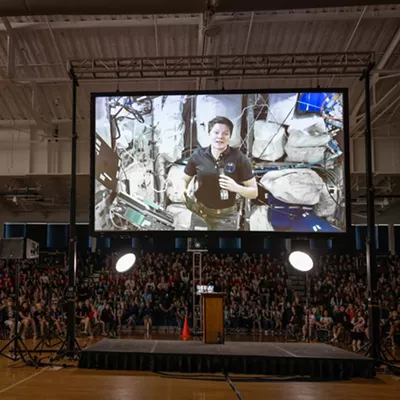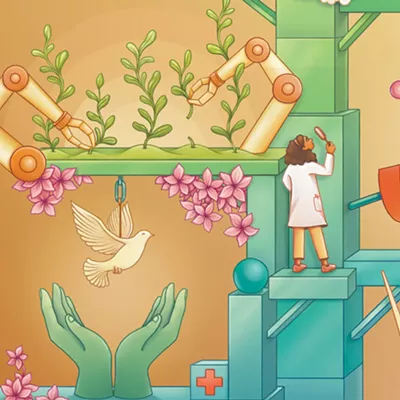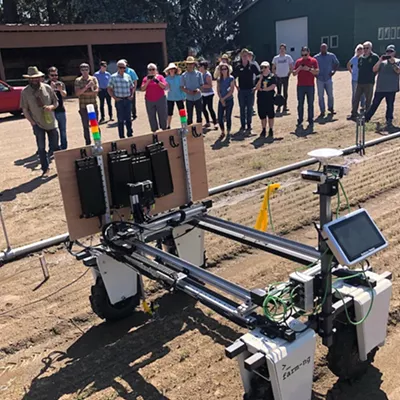It was Mardi Gras afternoon, and my family was turning on itself. Just two months after a difficult move from New Orleans, we'd returned to our city to see friends and celebrate our favorite holiday. Our house still hasn't sold, so we stayed there, sleeping in our old beds, eating food from our kitchen cupboards. The house, like much of the rest of our lives, is an August 29 time capsule.
Maybe she's just acting like a kid, I told myself. Maybe my eight-year-old daughter was taunting traffic on an empty street because she was physically spent from two days of eating king cake and catching beads and waking up early to see the Zulu parade. But I also wonder about how much death she's absorbed during this half year. The 1,300 counted victims of the flood. The 1,840 who are still missing. The thousands who are the flood's collateral damage -- including my wife's former boss, who hung himself after the storm. Now my daughter talks frequently about death. Last month, she wrote in a notebook that she doesn't think dying would be so bad. Is my oldest child suffering post-traumatic stress?
Fat Tuesday & r & It was a much-anticipated holiday, a much-debated holiday. For its part, America couldn't decide if New Orleans should hold a Mardi Gras this year. In the last week of February, CBS News took a poll that showed 46 percent saying the party must go on, with another 46 percent saying it should wait a year.
Last fall, New Orleanians in Atlanta had asked Mayor Ray Nagin how he could throw the celebration without them. How can a city party for 10 days when its citizens are living in trailers, living in hotels, living in gutted houses, living far away? Why should the city foot the bill to patrol parade routes when Judge Calvin Johnson was telling the national media that 4,500 prisoners might be released because there were no public defenders to protect their constitutional rights?
Meanwhile, in New Orleans, many people were loudly proclaiming that Mardi Gras must happen. That the city wouldn't be New Orleans without it. That anyone who suggests otherwise isn't a true New Orleanian. It's the new New Orleans patriotism: Purple, gold and green ... these colors don't run.
But in the weeks leading up to Mardi Gras season, the news from New Orleans kept getting worse. The city's infrastructure -- everything that undergirds a typical city, from the courts to the hospitals -- was crumbling. The president's State of the Union speech struck particularly hard. He still refused to share with the country the few simple facts that New Orleanians all know: What happened in those first weeks of September was the result of human failure, not a natural disaster. The federal levees gave way and our city was flooded. But the president didn't even mention the tragedy until a few unspecific sentences at the end of the speech. He even declined to call for a moment of silence for those who died.
And then Mardi Gras. The week before we left for New Orleans, I got a call from a friend. "It's terrible," he said of the first weekend of parades. The most noticeable change from past years: Street scenes that formerly were integrated -- at least for the duration of a parade -- were now all-white. And parades were eerily quiet, with far fewer marching bands. The bands represent local schools. In New Orleans, most public schools are still empty.
Mardi Gras means "Fat Tuesday." It's traditionally the last day to celebrate before Ash Wednesday brings its reminders of mortality, the promise that we all shall return to dust. I'd always thought that New Orleans was a uniquely wise city for indulging such solemn foolishness. But now, after six months of constant reminders of mortality, what was left to celebrate?
Spirit of Service & r & You can dwell on the absences for only so long. In New Orleans, keeping sane means drawing close to people who are part of the solution. So on February 27, the day before Mardi Gras, I drove to Oretha Castle Haley Boulevard, a strip of progressive storefronts that includes a soul-food restaurant/jobs-program center called Caf & eacute; Reconcile, the Juvenile Justice Project of Louisiana, and the Ashe Cultural Arts Center. Most stores were closed this Monday, but Ashe's windows advertised something called the Mardi Gras Service Corps.
The room was quiet, with stacks of literature and a half-eaten king cake on a folding table. Ashe director Carol Bebelle emerged from her office to say she'd just seen off that morning's contingent of Mardi Gras Service Corps volunteers, who're helping families clean their homes and neighborhoods. About 10 people had set out from here today. Sunday had 74 volunteers. We sat down on metal chairs, in a room decorated with pictures from New Orleans' past, pictures of street parades and brass bands and working men dressed in tuxedos. The Corps was started to answer the public doubts about this year's holiday, Carol said: "Mardi Gras doesn't work as well for us outside New Orleans as it does inside. The most eloquent of speakers cannot craft a response to the question, 'Why are you having Mardi Gras in such a disaster?'"
I told Carol, who is black, that white friends of mine say that racists are more emboldened in post-Katrina New Orleans. They're dropping the codes and throwing around the n-word more freely, talking openly about how the city is better off now that the demographics have shifted. Even Oliver Thomas, a popular city councilman who is African-American, is saying that the housing projects shouldn't be open to people who want to come back and watch soap operas all day -- as if the real problem in New Orleans is people who don't want to work.
"My sense is that we're as separate as we've ever been," Carol said. "Maybe more so -- because now we're really separated into different places. But I think there's also a new willingness to grapple with what separates us, maybe more so than anytime since the Civil Rights era. There's a conversation going on now."
Carol grew up in New Orleans. For her, for everyone I know in this city, Mardi Gras is about families and neighborhoods. At 56, she remembers the day in 1967 when the all-black St. Augustine Marching 100 first joined the all-white Rex parade, marching proudly as some whites on the sidelines taunted them. This is one of those landmark years, too.
"There's plenty of greed left in this city," she said. "But we can't even consider the possibility that it will take over the rebuilding. If we do that, it's over."
Parade of Misery & r & Mardi Gras dawned, warm and sunny. At Jackson Avenue, we joined the crowds lunging toward Zulu's floats, dodging chunks of concrete on the pocked sidewalk. This stretch of road was as mixed as our section of Napoleon Avenue was all-white. Behind us, charred skeletons of burned houses were roped off by police tape; no search-and-rescue markings could tell us the story of what had happened there, or to whom. As we walked back home through the once-flooded neighborhood, the spirit drained from us. Yet somehow we got the devil and the lion into the car, and drove toward the French Quarter.
Along the way, we spotted a few pickup trucks alongside housing projects, grills propped up in back. Under the Claiborne Avenue overpass, there were more grills and picnics, just blocks away from rows of flooded cars still waiting to be removed. Families across the city were joining in. Looking around, I thought about how this was not an easy day for any of us. But as we parked the car, a Carnival spirit was taking hold around us. The Zulu parade was disbanding into smaller second lines, which were strutting through neighborhoods in joyful acts of reclamation. We passed tribes of Mardi Gras Indians who were loudly taking over their sections of the city. One Big Chief said his costume was blood-red this year, to help him remember.
We kept walking, pulling the devil and the lion in a red wagon. The kids started tossing beads. I saw that New Orleanians were using the materials of the past six months for their costumes. There were blue-tarp suits, blue-tarp dresses, blue-tarp pants and blue-tarp shirts. Suits made from Meals Ready to Eat (MRE) boxes. Clothes made from envelopes, held together by yellow forwarded-mail stickers. Naked people were literally tied up in red tape. A man had a small tent for a hat and a sign that read, "My head is my only house."
On Bourbon Street, a chef with a food cart showed off his "Katrina Deli," passing out menus that included "Mold Mold" as a starter, "Chicken Shit au Fema" as an entree, and "Creamed Maison du Jour" as a side. A line of blind men wearing FEMA suits announced that they were searching for the Superdome. Some costumes were elaborate -- none more so than the man in a rescue basket, with a wired-up helicopter overhead. Others just donned the same white jumpsuits they'd been wearing to gut their houses, and hit the streets.
Tomorrow, Ash Wednesday, we would return north, with so many other evacuees who can't live here right now. But on Mardi Gras this year, we joined New Orleanians doing what they always do, turning themselves inside out.
Mardi Gras was a parade of misery, and everywhere you looked, people were laughing.
Michael Tisserand is the former editor of Gambit, the alternative newsweekly in New Orleans. Although Gambit has resumed publication, Tisserand has relocated to Chicago. You can find his 10 previous dispatches in his "Submerged" series at www.altweeeklies.com.
















